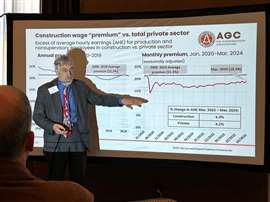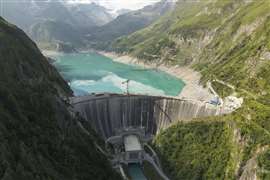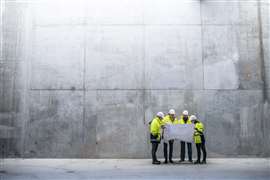Read this article in Français Deutsch Italiano Português Español
3 takeaways from AGC’s ‘one-of-a-kind’ decarbonisation playbook
24 April 2024
The Associated General Contractors of America (AGC) released – on 22 April – what it called ‘first-of-its-kind’ guidance on how US construction firms and contractors can assess, track, and reduce greenhouse gas emissions.
 Associated General Contractors of America (AGC) chief economist Ken Simonson presents to the AGC Greater Milwaukee chapter in Wisconsin, US, on 24 April. (Image: Mitchell Keller)
Associated General Contractors of America (AGC) chief economist Ken Simonson presents to the AGC Greater Milwaukee chapter in Wisconsin, US, on 24 April. (Image: Mitchell Keller)
Officially titled The AGC Playbook on Decarbonization and Carbon Reporting in the Construction Industry, the trade association unveiled its contents and mission alongside a webinar briefing.
Written by member contractors for contractors, AGC CEO Jeff Shoaf said, “This new tool will help firms understand the basics of tracking carbon emissions, including who is responsible for those emissions, how to track them and what are the best ways to cut them.”
Work on the playbook – by AGC’s Decarbonization and Carbon Reporting Task Force, which consists of construction leadership from across the country – started in early 2023, and it offers advice for how firms can track and hold accountable the various carbon emission reduction needs associated with a project. It also outlines how to document information and includes resources to help companies calculate the carbon footprint of their work.
“It also lays out ways for firms to track and report emissions related to the construction process itself, including carbon emissions from transporting materials and operating equipment on the jobsite,” said AGC. “In addition, the document offers a host of industry-identified strategies and tips for reducing carbon emissions from their projects, from proposing alternative, less carbon-intensive materials to ways to operate more efficient jobsites.”
Discussing the playbook on 22 April were task force chair and vice chair Myrrh Caplan (senior VP of sustainability at Skanska USA) and Joe Rozza (chief sustainability officer with Ryan Companies US). Joining from AGC was Brian Turmail (VP of public affairs and strategic initiatives) and Melinda Tomaino (senior director, environment, and sustainability).
1. The US is sprinting toward a decarbonised future in four major sectors
AGC’s playbook is clear at the onset its purpose: a tool to help contractors and subcontractors prepare and plan for decarbonisation projects and carbon reporting.
The need for such a document, AGC said, is because the US government, as well as private investment pressure, will not be backing off decarbonisation goals anytime soon.
“The federal government has made climate change a national priority and is advancing numerous policy initiatives that will impact the construction industry and its markets,” said the playbook. “In addition to regulatory initiatives, federal agencies are adopting green guidelines and standards for new construction and major renovation.”
And on the private side, “many Fortune Global 500 companies have published targets related to climate change, including net zero goals or emission reduction goals,” said the playbook.
With each year, more private institutions are establishing specific environmental, social, and governance (ESG) goals “as the pressure to act on climate is mounting.”
4 sectors to watch in US decarbonisation
AGC identified four major construction sectors where decarbonisation opportunities and processes will be vital going forward: building, federal and heavy projects, highway and transportation, and utility infrastructure.
For the building sector, in the US, structures consume nearly 40% of the nation’s energy, said AGC, which includes lighting, heating and cooling, appliances and electronics. The playbook estimated that 31% of the nation’s total man-made greenhouse gas (GHG) emissions in 2022 were from the building sector. Whether creating monitoring program’s for on-site LED usage or simply assigning a site manager to monitor idling machines can produce enormous gains in emission reduction.
In the federal and heavy segments, the US General Services Administration (GSA) has US$3.9 billion worth of unmet maintenance and modernisation needs, said AGC. This includes federal buildings including military facilities, prisons, border stations, and embassy compounds. Structural deficiencies across the county for major infrastructure like bridges and utilities like dams, levees, and pumping stations, are prime segments regulated publicly and privately with ESG and decarbonisation expectations.
At present, AGC noted transportation emissions are almost exclusively from the combustion of fossil fuels. In 2022, AGC said transportation contributed 29% of total manmade GHG gas emissions, and traffic congestion wasted 3.3 billion gallons of fuel in 2017. Transportation construction projects are likely to highlight the right mix of traffic congestion mitigation, speed management and ‘traffic smoothing’ measures, which could lower total carbon dioxide (CO2) emissions from vehicles by as much as 30%, according to the playbook.
As for utilities, the nation’s drinking water and wastewater infrastructure, particularly aging networks, are in dire need of attention, and are assured to be built with the highest of ESG standards.
“In 2010, the U.S. Environmental Protection Agency (EPA) and the Congressional Budget Office warned of a massive investment gap over the next 20 years within the drinking water and wastewater sector,” said the playbook. “A recent study shows the annual investment gap is expected to reach $434 billion by 2029.”
Future project in utilities are likely to focus on wholesale upgrades for municipal systems. Those systems’ aged and leaking infrastructure, AGC said, are responsible for billions of gallons of lost water every day.
“And, in many parts of the country, wet weather events regularly lead to overflowing systems that release waste and chemicals into the environment — damaging aquatic ecosystems and causing human illness,” added AGC.
2. There’s no competition in sustainability
Noting the collaboration of the project – which included input from executives and leadership from Skanska, Ryan, Granite, Kiewit, Turner, M.A. Mortenson, DPR, and Clark – both Caplan and Rozza recognised that, if the US is to make meaningful gains on decarbonisation goals, it cannot silo sustainability gains internally.
While companies and contractors might continually be in competition for work and labourers, Caplan said the spirit of sustainability is in cooperation.
“Sustainability, at its roots, is about sharing and bringing everyone up together,” she said.
Rozza noted, particularly for main contractors that rely on networks of subcontractors, using internal proprietary processes for tracking and mitigating carbon emissions can be counterintuitive.
“This pre-competitive work, this is really stuff that we do as an industry,” said Rozza. “We’re all facing the same pressures. There are policy pressures… you’ve got Senate Bills in California requiring carbon reporting, you’ve got other states requiring different levels of carbon reporting, you’ve got clients putting it into their procurement document [that] they need reductions.”
He acknowledged that each firm attempting to create its own language and measurements regarding carbon reduction complicates a mission that’s meant to cultivate circularity. Having hundreds of differen measurements, too, opens the door to mistrust and manipulation.
“There are these policy forces, there’s these market forces, which portends risk for the American construction industry,” he added. “We’ve got to have some structured approach to how we’re going to deal with all of this.”
Creating a common approach – whether it’s contract or bid language or methods for tracking carbon emissions – doesn’t entirely eliminate healthy competition among firms, though.
“For folks that have [a] competitive mindset… innovations that help produce lower carbon, generally, there’s probably some space for companies to invest in stronger capabilities, R&D innovation to do things in a more sustainable way,” said Rozza, noting the playbook isn’t asking companies to share all their secrets. “This document is all about structured approach, common approach, for some of the basic components of understanding emission sources and some basic practices on how to decarbonize.”
3. Decarbonisation will rely on documentation, data, and delegation
What AGC’s playbook encourages more than anything is collaborative and streamlined communication that relies on accurate data and documentation.
It should go without saying, but if carbon emissions are not being measured throughout the length of a project (by all stakeholders), it would be impossible to make any corrective actions to reduce the output.
Both Rozza and Caplan emphasised the importance of structured carbon emissions tracking, and provided several steps to illustrate how incongruent measurements between companies might caught major issues.
“You’ve got contractors that may be private, but they could be reporting [carbon emission measurements] into a publicly traded company that could be reporting those emissions as part of their financial reporting,” said Rozza, noting if the private-company’s assessments are inaccurate or misleading, it could spell major issues for both parties and the project. “There’s some need to have good structure and to take reporting very seriously.”
Within the playbook, AGC offers suggestions on how project managers can breakout and delegate tracking and data collection. From transportation fuel to electricity usage to job-site functionality, every aspect should be tracked by a predetermined stakeholder, who shares that information up and downstream with other project partners.
To reach its goals, US construction industry needs to change
While the US lacks federal consistency on sustainability initiatives, in order to secure major civic/public projects, and in order to satisfy green investors and private institutions, contractors and construction companies will need to modernise their carbon emissions tracking and reporting or risk being left out of million-dollar and billion-dollar builds.
To avoid eventual federal intervention (in the form of regulation), the onus is on the industry to adapt, and AGC’s playbook, for now, serves as an initial plan for how US construction can adjust.
STAY CONNECTED


Receive the information you need when you need it through our world-leading magazines, newsletters and daily briefings.
CONNECT WITH THE TEAM











